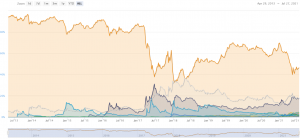Bitcoin forks caused market mayhem not too many years ago. Fewer hard forks have supported greater crypto adoption into the mainstream. This united front will need to continue to support greater adoption going forward.
Since the Beginning
In response to the global financial crisis of 2008, Satoshi Nakamoto ventured into the unknown and delivered the global financial markets with Bitcoin and blockchain tech.
Bitcoin’s creator set on a path to bring to end the control that central banks held over the global financial markets.
The concept and ideology of blockchain and ultimately Bitcoin was to allow the community to advance the technology on a united front in a bid to bring down central banks and the world’s largest financial institutions.
Things have not turned out, perhaps, how Satoshi had intended.
Miners vs Developers
In order to police and keep Bitcoin and the blockchain world moving forward, Bitcoin and the crypto community, not only needed developers, but also miners to verify transactions on the Bitcoin network and other crypto networks.
In contrast to Satoshi’s ambition to decentralize, miners and developers, have on occasion, fallen into disagreement over blockchain enhancements and/or developments.
For Bitcoin, minors had cornered the market with mining farms, leaving want-to-be minors out in the cold. This also meant that the income stream was just too large to give up control. Decentralized became centralized in a matter of years.
As a result, the Bitcoin community and the crypto community became divided between those in search of crypto income and the ideologists looking to continue to prize control from governments, central banks, and the world’s largest financial institutions.
This divergence in view and intent ultimately led to the splitting of crypto communities. The crypto technical term for this being a “Fork.”
The Fork
In the crypto sphere, there are two types of forks that investors need to be concerned with. The first and generally of little impact to value and the broader market are soft forks.
In the event of a soft fork, only one blockchain remains valid, with users adopting the changes made to the blockchain.
By contrast, hard forks can have a material impact on price in the lead up and immediate aftermath of a fork.
In a hard fork event, both blockchains coexist. The coexistence occurs from nodes continuing to support the original blockchain.
In some instances, therefore, both blockchains can coexist and remain prominent in the crypto market place. This is when there is sufficient support for both the old and the new versions.
In some cases, however, nodes may eventually shift to the new version, leaving the old blockchain obsolete.
From an investor perspective, an important feature of a hard fork is that holders of the original crypto are awarded the new coins upon completion of the hard fork.
In the case of a successful hard fork, where both chains coexist, the value of the coins can increase substantially.
For this reason, anticipation and an eventual hard fork can have a material impact on price and crypto market volatility.
Since Bitcoin’s creation, the total number of cryptos in the market place have surged to a whopping 11,064 based on numbers from CoinMarketCap.
Notably, in spite of numerous soft and hard forks, Bitcoin (“BTC”) continues to be the dominant crypto.
The 2017 Convergence
Back in late 2017, we did see Bitcoin’s dominance converge with the likes of Ethereum. This coincided with Bitcoin’s first major hard fork, which resulted in the creation of Bitcoin Cash (“BCH”).
While Bitcoin Cash (“BCH”) enjoyed a lengthy period in the top 10 by market cap, a Bitcoin Cash hard fork in late 2018 led to the creation of Bitcoin Cash ABC and Bitcoin Cash SV.
The Bitcoin community have not been alone in dealing with hard forks.
Ethereum hard forked, leading to the creation of Ethereum Classic. In this case, Ethereum Classic maintained the old blockchain history. We also saw Litecoin hard fork, leading to the creation of Litecoin Cash.
In spite of disagreements between respective developers and the communities, however, Bitcoin, Ethereum, and Litecoin have all remained the dominant chain.
Lessons Learned
Major disagreements between developers and communities can lead to significant disruption. More importantly, market stability also comes into question.
Since the headline grabbing hard forks of Bitcoin, Ethereum, and Litecoin, the number of notable hard forks have fallen.
Developers and nodes working together to achieve Satoshi’s ambition of toppling central banks is now a more plausible outcome. Infighting had led to significant disruption and ultimately a marked decline in value.
Stability across the major crypto blockchains have supported the increased adoption. The increased adoption contributed to Bitcoin’s surge to an all-time high $64,829.0, struck in April 2021.
While volatility across the market place will unlikely abate anytime soon. The absence of hard forks and infighting, however, would serve the crypto community and investors well in the short to medium term.





